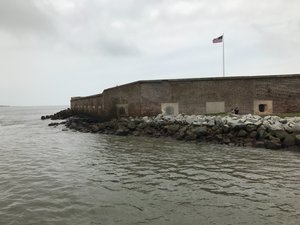Advertisement
Published: April 29th 2017

 IMG_0607
IMG_0607
Approaching Fort SumterFort Sumter National Monument, Charleston, South Carolina
Ended up Trump didn't shut down the government quite yet - we apparently get another week or so. But there was a surreal quality to viewing Sumter, with all its civil war importance, at the same time that we are dealing with Trump and the expression of right wing politics. After going to graduate school forty years ago in North Carolina, I understood that the civil war was by no means over. And here we are now in the center of red-state country while the ongoing fight continues.
It was interesting and a bit thrilling to stand in the center of Fort Sumter yesterday. To actually be in the spot where the civil war finally ignited in bloody violence is a bit humbling. In the wee hours of the morning on April 12, 1861, confederate forces gave the small Federal garrison at Sumter notice that they would begin firing in an hour and ordered them to surrender. The union forces refused, of course, and the firing commenced as promised. Thirty hours later, Sumter was on fire and in tattered ruins and the Union forces surrendered. United States forces spent the next four

 IMG_0608
IMG_0608
Inside the Fort - Ranger Giving Talkyears trying to retake the fort, bombarding it with some 40,000 shots (an estimated 7 million pounds of projectiles)- reducing the fort to little more than rubble. But it took Sherman's march upward from Savannah to force the confederate evacuation and the fort only then returned to union hands.
The fort itself was one of the 42 the United States decided to build after Britain sacked the capital in 1812. And, although it seems smaller than Fort Pickens or Pulaski, that might be because a huge, black, concrete 'battery' structure was built inside the fort in 1899 to house much larger guns during the Spanish American war. Like the other forts of its generation, it was shaped as a pentagon (right angles are hard to defend). Also, like the other forts, it was never really completed. When union forces decided to move into the fort, in December, 1860, they joined a force of slave labor and other construction workers who were still working on finishing the second floor of a planned three floor construction. And, like all the other forts we've visited, it was not fully armed having just a few of the cannons it was designed for. Although

 IMG_0610
IMG_0610
Casements - Pretty much the same in all fortsSumter had a strategic location in the middle of Charleston harbor, it never really fired anything near what it was designed to fire.
After touring the fort, which requires a ferry ride through the harbor, we drove down to the lower part of the peninsula to see the historic district. Ate a late lunch (lunner?) at Fleet's Landing, a seafood place on the waterfront with views of the harbor. We ordered a few appetizer plates and shared, starting with a wonderful she-crab soup, with meaty chunks of crab in a cream sauce that you pour drops of sherry in, to taste. The combination was terrific. Also had fried oysters in a southern BBQ sauce that sounds strange, but was really pretty good. Joan didn't care for the hush puppies stuffed with crabs, so I enjoyed hers! Washed everything down with a drink, called The King and I, made of bourbon, ginger beer, and jalapeño peppers.
After eating, we tried to walk off some of the calories by touring the French Quarter mansions. I don't know the history, so I don't know how the town has a 'French' quarter, but the houses are colorful (and huge). Walking the cobblestone

 IMG_0613
IMG_0613
Difficult for Me to Get Through That Doorstreets, staring at the mansions, was a lot of fun, even if the humidity must have been 95%.
One thing I found obvious was that there is a lot of money here in Charleston - the mansions downtown and the investment in the county park system (our campground) clearly indicate an abundance of resources. Add that understanding to the civil war history as well as the contemporary political scene and I'm puzzled. I can't quite put my finger on it yet. But I sense another essay coming that will try to tie together Red States, the Trump 'Revolution', the civil war, and southern wealth. Was the civil war about 'States rights', or was that an ideology constructed to justify actions that were really blatant attempts to preserve the material interests of plantation elites? And is the current Trump populism anything more than another desperate attempt by certain moneyed interests to maintain, even to expand their financial empires (Trump tax plan anyone?). And it is all very curious that both of these movements originate from right here in the Deep South! (17.1.52)
Advertisement
Tot: 0.202s; Tpl: 0.016s; cc: 6; qc: 24; dbt: 0.1773s; 1; m:domysql w:travelblog (10.17.0.13); sld: 1;
; mem: 1mb
















